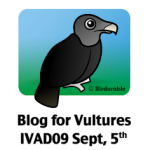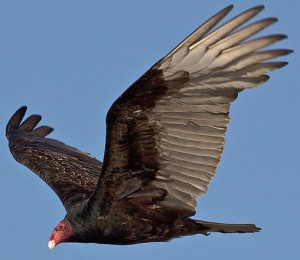 Sept 5 is the first International Vulture Awareness Day. What does that have to do with birdwatching in Canada, you ask?
Sept 5 is the first International Vulture Awareness Day. What does that have to do with birdwatching in Canada, you ask?
Although most people are unaware of it, Canada does have a resident vulture species.
Turkey vultures have been expanding their range northward in the last few years, and can now be seen across the southern prairies, as well as parts of BC and Ontario. Their numbers are increasing in Alberta and Saskatchewan, likely because of the exploding white-tailed deer population. Their huge natural range extends from central Alberta down to the tip of South America.
These massive birds can be found soaring over open country, pastures, grasslands, and wetlands. Their range northward in Canada will likely be restricted to areas south of the heavily treed boreal forest.
At first glance, these vultures may be misidentified as a very large bird of prey. Closer inspection, however, will reveal a purplish-red, featherless head and neck. Dark brown to black plumage and a short, hooked, ivory coloured beak complete the identification. Covering large areas, these graceful birds seldom flap their wings, but float across the sky on thermal air currents.

Turkey vulture in flight
With a wingspan up to six feet, a height of 3 feet and a weight up to 5 pounds, turkey vultures are impressive birds. They are certainly not cute little songbirds, but act as a natural cleaning service, consuming carrion from road kills and animals that have died a natural death. Our guide in Florida referred to animals killed on the highway as TV dinners, which certainly put their worth into perspective.
Turkey vultures use their keen vision and excellent sense of smell to locate food, flying low enough to detect the gasses produced by decaying animals. The part of their brain responsible for processing smells is particularly large, compared to other birds. This heightened ability to detect odours allows them to find dead animals from a vast distance.
Vultures are among the most sadly misunderstood birds in the world. In a society based on acceptance by appearance, vultures are labelled ugly birds, and receive no recognition for their vital role in the ecosystem.
While the turkey vulture population is thought to number 4,500,000 individuals, other vulture species in the world are not so lucky. Populations of some Old World Vultures in India, Nepal and Pakistan have declined up to a horrifying 99% over the past few years, and many are now critically endangered.
The major cause of the population decline was identified as diclofenac, an anti-inflammatory drug widely given to livestock across South Asia. The drug keeps animals that are ill or in pain working on the land for longer, but, if the ill animals die, their carcasses contain diclofenac. Farmers leave the dead animals out in the open, relying on vultures to tidy up. The birds suffer kidney failure, visceral gout, and death as a result of diclofenac poisoning.
Without the vultures to consume animal carcasses, diseases spread quickly, and packs of wild feral dogs increase. Wild dogs also carry rabies, and the spread of that disease in certain countries has exploded.
Conservationists in Africa, Europe and south east Asia are starting to establish vulture restaurants, providing the big birds with clean, chemical-free carcasses. Results in some areas have shown a doubling of nesting pairs in just two years, according to Bird Conservation Nepal.
Sighting one of these birds floating over the Canadian prairies is a wonderful experience. Salute them for their work on our behalf when you see one!
International Vulture Awareness Day 2009
Vultures are an ecologically vital group of birds that face a range of threats in many areas that they occur. Populations of many species are under pressure and some species are facing extinction.
The International Vulture Awareness Day has grown from Vulture Awareness Days run by the Birds of Prey Working Group in South Africa and the Hawk Conservancy Trust in England, who decided to work together and expand the initiative into an international event.
It is now recognised that a co—ordinated international day will publicise the conservation of vultures to a wider audience and highlight the important work being carried out by the world’s vulture conservationists.
On September 5th 2009, the aim is for each participating organisation to carry out their own activities that highlight vulture conservation and awareness. This website, established in July 2009, provides a central place for all participants to outline these activities and see the extent of vulture conservation across the world.



Loved the post…so much information!! Vulture restaurants…now that’s interesting–and seems to be working if the number of nesting pairs has doubled.
I love the title of this post, Pat. 🙂
A very good read. Thank you for supporting Blog for Vultures.
Pingback: Tweets that mention Hug A Vulture Today -- Topsy.com
Thanks for bringing attention to this overlook and maligned bird. The info on their sense of smell was new for me – fascinating. Hurray for vultures.
Pingback: Hug A Vulture Today | Today Headlines
Pingback: Hug A Vulture Today | condors
Great post and information about our forgotten Turkey Vultures. I completely agree that they “receive no recognition for their vital role in the ecosystem.”
I hope the IVAD09 proves successful.
Pingback: Hug A Vulture Today | centralafrican